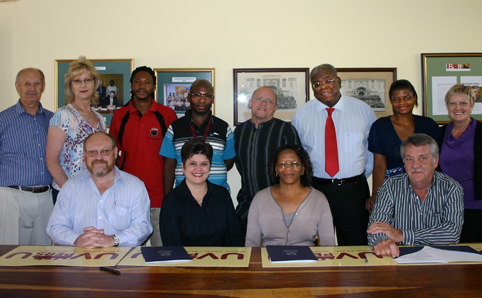 |
At this year's salary negotiations were from the left, front: Mr Lourens Geyer, Director: Human Resources; Ms Ronel van der Walt, Manager: Labour Relations; Ms Tobeka Mehlomakulu, Vice Chairperson: NEHAWU; Prof. Johan Grobbelaar, convener of the salary negotiations; back: Mr Ruben Gouws, Vice Chairperson of UVPERSU, Ms Esta Knoetze, Vice Chairperson of UVPERSU, Mr David Mocwana, fultime shopsteward for NEHAWU; Mr Daniel Sepeame, Chairperson of NEHAWU, Prof. Nicky Morgan, Vice-Rector: Operations; Prof. Jonathan Jansen, Vice-Chancellor and Rector of the UFS; Ms Mamokete Ratsoane, Deputy Director: Human Resources and Ms Anita Lombard, Chief Executive Officer: UVPERSU.
Photo: Leonie Bolleurs |
Salary adjustment of 7,5%
The University of the Free State’s (UFS) management and trade unions have agreed on a general salary adjustment of 7,5% for 2012.
The negotiating parties agreed that adjustments could vary proportionally from a minimum of 7,3% to a maximum of 8,5%, depending on the government subsidy and the model forecasts.
The service benefits of staff will be adjusted to 9,82% for 2012. This is according to the estimated government subsidy that will be received in 2012.
UVPERSU and NEHAWU sign
The agreement was signed (today) Tuesday 8 November 2011 by representatives of the university’s senior leadership and the trade unions UVPERSU and NEHAWU.
R2 500 bonus
An additional once-off, non-pensionable bonus of R2 500 will also be paid to staff with their December 2011 salary payment. The bonus will be paid to all staff members who were in the employment of the university on UFS conditions of service on 31 December 2011 and who assumed duties before 1 October 2011. The bonus is payable in recognition of the role played by staff during the year to promote the UFS as a university of excellence and as confirmation of the role and effectiveness of the remuneration model.
It is the intention to pass the maximum benefit possible on to staff without exceeding the limits of financial sustainability of the institution. For this reason, the negotiating parties reaffirmed their commitment to the Multiple-year, Income-related Remuneration Improvement Model used as a framework for negotiations. The model and its applications are unique and have as a point of departure that the UFS must be and remains financially sustainable.
Capacity building and structural adjustments
Agreement was reached that 1,54% will be allocated for growth in capacity building to ensure that provision is made for the growth of the UFS over the last few years. A further 0,78% will be allocated to structural adjustments.
Agreement about additional matters such as funeral loans was also reached.
“The Mutual Forum is particularly pleased that a general salary adjustment of 7,5 % could be negotiated for 2012. Taken into account the world financial downturn, marked cuts in university subsidies and the growth of the university, this is a remarkable achievement,” says Prof. Johan Grobbelaar, Chairperson of the Mutual Negotiation Forum.
Increase for Professors, Deputy and Assistant Directors
According to Prof. Grobbelaar the Mutual Forum is also pleased that Professors and Deputy and Assistant Directors will benefit from the structural adjustments. These increases will align the positions with the median of the higher education market. The 1,54% allocated for growth will ensure that appointments can be made where the needs are the highest. The special year-end bonus of R2 500 is an early Christmas gift and implies that the employees in lower salary categories receive an effective increase of almost 9,5 %.
“The UFS is in a unique position when it comes to salary negotiations, because the funding model developed more than a decade ago, has stood the test of time and ensured that the staff receive the maximum possible benefits. Of particular note is the fact that the two majority unions (UVPERSU and NEHAWU) work together. The mutual trust between the unions and management is an example of how large organisations can function to reach specific goals and staff harmony,” says Prof. Grobbelaar.
The implementation date for the salary adjustment is 1 January 2012. The adjustment will be calculated on the total remuneration package.